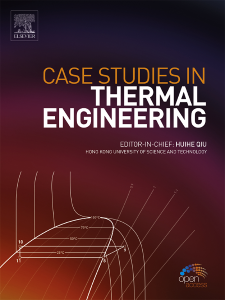Artificial neural networks-based multi-objective optimization of immersion cooling battery thermal management system using Hammersley sampling method
IF 6.4
2区 工程技术
Q1 THERMODYNAMICS
引用次数: 0
Abstract
This research optimizes lithium-ion battery module cooling through immersion cooling, addressing pressure drop and after discharge average cell temperature. Using the Hammersley method, various module designs are generated. Multi-objective optimization, using ANN-based multi objective genetic algorithms, is conducted on a 16S1P configuration at 4C discharge and 0.008 kg/s. The optimized design achieved an 83 % average cell temperature reduction at a 4C discharge rate and 0.008 kg/s compared to an uncooled battery cell, while also reducing the pressure drop by 88.6 % relative to the base design. The pressure drop is approximately 12 Pa at a mass flow rate of 0.02 kg/s, with an average cell temperature of 3.13°C in the optimized design. This represents a 68.4 % reduction in pressure drop compared to the base design, which experiences approximately 40 Pa at a lower mass flow rate of 0.008 kg/s. Additionally, the optimized design achieves a 20.8 % reduction in average cell temperature, lowering it from 3.95°C in the base design to 3.13°C. These findings highlight improved pressure and thermal performance in lithium-ion battery modules, with implications for enhanced design and operation. Future work could extend these optimizations to various battery chemistries and conditions.基于人工神经网络的浸入式冷却电池热管理系统多目标优化(使用哈默斯利采样法
这项研究通过浸入式冷却优化了锂离子电池模块的冷却,解决了压降和放电后电池平均温度的问题。使用哈默斯利方法生成了各种模块设计。在 4C 放电和 0.008 kg/s 条件下,使用基于 ANN 的多目标遗传算法对 16S1P 配置进行了多目标优化。在 4C 放电率和 0.008 kg/s 放电速度下,与未冷却电池相比,优化设计使电池平均温度降低了 83%,同时压降也比基本设计降低了 88.6%。在优化设计中,质量流量为 0.02 kg/s 时,压降约为 12 Pa,电池平均温度为 3.13°C。与基本设计相比,压降减少了 68.4%,基本设计在 0.008 kg/s 的较低质量流量下的压降约为 40 Pa。此外,优化设计还使电池平均温度降低了 20.8%,从基本设计的 3.95°C 降至 3.13°C。这些研究结果表明,锂离子电池模块的压力和热性能得到了改善,对提高设计和运行性能具有重要意义。未来的工作可以将这些优化扩展到各种电池化学成分和条件。
本文章由计算机程序翻译,如有差异,请以英文原文为准。
求助全文
约1分钟内获得全文
求助全文
来源期刊

Case Studies in Thermal Engineering
Chemical Engineering-Fluid Flow and Transfer Processes
CiteScore
8.60
自引率
11.80%
发文量
812
审稿时长
76 days
期刊介绍:
Case Studies in Thermal Engineering provides a forum for the rapid publication of short, structured Case Studies in Thermal Engineering and related Short Communications. It provides an essential compendium of case studies for researchers and practitioners in the field of thermal engineering and others who are interested in aspects of thermal engineering cases that could affect other engineering processes. The journal not only publishes new and novel case studies, but also provides a forum for the publication of high quality descriptions of classic thermal engineering problems. The scope of the journal includes case studies of thermal engineering problems in components, devices and systems using existing experimental and numerical techniques in the areas of mechanical, aerospace, chemical, medical, thermal management for electronics, heat exchangers, regeneration, solar thermal energy, thermal storage, building energy conservation, and power generation. Case studies of thermal problems in other areas will also be considered.
 求助内容:
求助内容: 应助结果提醒方式:
应助结果提醒方式:


